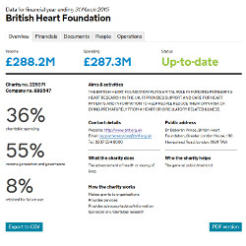Gareth Jones argues that changes need to be made to the Commission’s new charity register to protect public trust.
They say that every cloud has a silver lining. Gina Miller, who this weekend published a report accusing charities of not spending enough on charitable activities, is certainly quite a black cloud, although I’ve no doubt she’ll blow over quite quickly.
The silver lining, meanwhile, is that she hovered over the charity sector at a time when the Charity Commission’s new online register is still in the beta testing stage.
For this new Charity Register website has introduced new measures of charity spending which Gina Miller used to further her agenda and which may give members of the public a bad impression of certain charities.
The case for trading
As was explained to Gina Miller numerous times prior to the release of her report, if a charity engages in trading activities, then inevitably a portion of its spending will go on generating that income rather than directly to the cause.
In the case of the British Heart Foundation (BHF), which superficially only spends 46 per cent of its funds on “charitable activities”, its income generation expenditure is mostly staffing and rental costs for its charity shops.
But the fact that it makes a profit from its trading means more money still makes its way to charitable activities than if it relied solely on voluntary donations.
Register changes
However, the new register presents raw figures which fail to make this clear.
On the old site, a visitor to BHF’s page sees a moderately-sized pie chart for “spending” sat amongst several other graphics. Closer interrogation reveals that 49 per cent of spending was on “trading to raise funds”.
On the new site, the entire left-hand column is devoted to three large percentage figures. The first states that only 36 per cent of BHF’s expenditure was “charitable spending”, while the second explains that 55 per cent went on the rather vague “income generation and governance”.
The third exclaims that 8 per cent was “retained for future use”, which has its own negative connotations.
This new format is misleading in four ways:
- While the previous phrase “trading to raise funds” made clear that trading has the purpose of funding charitable objectives, “income generation and governance” gives the impression of money wasted on fundraising agencies and trustee meetings.
- By pitching the income generation figure directly opposite “charitable spending”, it implies that income generation spending is money that could have been going directly to the cause.
- The sheer size of the three main percentage figures invites the reader to believe that these are most important measures of charity effectiveness.
- No context is offered to explain or justify these three metrics.
What now
The Charity Commission has emphasised that the new register is still in the beta stage. It says it has received “considerable user feedback” on the percentages and other features, and will “reflect that feedback in developing the new tool”.
For now we will give them the benefit of the doubt, and accept that this may be changed in the near future. To its credit, the Commission did publicly criticise Gina Miller’s methods.
It remains one of the Commission’s stated priorities to “develop public confidence in the charity sector”. Displaying information in this way risks doing the opposite.









